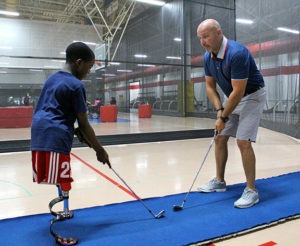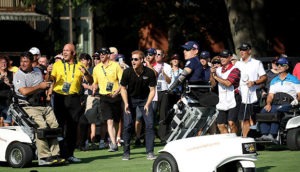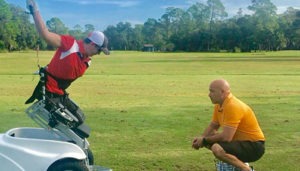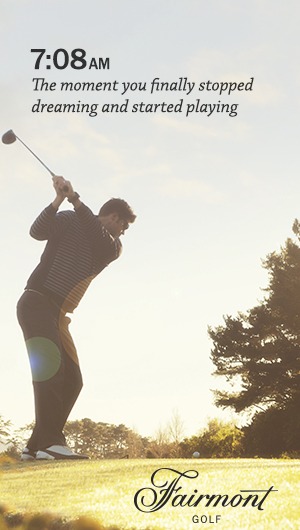While the golf industry continues to pull its hair out over the illogical temporary lockdown of facilities in Ontario, the already follically challenged Todd Keirstead is addressing more long-term access issues across the country.

Keirstead works with Feranmi Oyegunle during a Variety Village program in 2019.
A noted champion of disabled golf, Keirstead has just launched ParaGolfCanada.com, a website and national adaptive program dedicated to promoting “involvement in the game for people of all abilities, empowering everyone with the chance to play the game and develop their potential regardless of the severity of their disability.”
Essentially a pathway from the first tee to the podium, it includes such stages as a National Grassroots and Development Program, which “provides an opportunity for individuals of all ages and abilities to learn the fundamentals of paragolf and play in a healthy, friendly and welcoming environment.”
Other components include a Junior Development Program and National Level Playing Program, the latter of which will cater to those with more competitive goals in mind.
While each of those programs currently exists in some form at the provincial or national level, Keirstead has added a crucial missing ingredient to the recipe—a means of classifying and ranking participants.
“We are going to take individuals of all disabilities and classify them based on their deficiencies,” explains Keirstead, a ParaSport Ontario board member and former competition supervisor at both the 2017 Invictus Games and 2019 Warrior Games. “While it’s great that we have the Ontario Disability Championship, for example, the only classifications in that tournament are ‘male’ and ‘female.’ So if you look at the individuals competing, you can have a below-the-knee amputee who is a +2 handicap competing against blind golfers, wheelchair golfers, players with cerebral palsy—that’s obviously not a fair and level playing field.

Prince Harry takes in the 2017 Invictus Games at St. George G&CC. (Photo: HELLO! Magazine)
“A classification system allows golfers to compete against others who have the same deficiency—above-knee amputee vs. above-knee amputee, those playing with one arm and an adaptive device against similar players, seated individuals against the same, etc.,” Keirstead continues. “With that classification in mind, I have created a ranking system, which is basically based on your handicap index of average scores. So now there’s a benchmark. Using their classification and index, you can have those with similar disabilities in one flight, or every disability within the same flight.”
Without those divisions, it’s a lot like forcing a 36-handicapper to compete in the A flight of a club championship, Keirstead notes. “One of my students has cerebral palsy and he’s ecstatic if he breaks 95, which he should be. But then he goes to an adaptive event without a classification, plays really well, and loses by 30 shots, which can be pretty discouraging. But if he had a classification, he might leave knowing that he is No. 3 player in Canada among other individuals with cerebral palsy. It gives him a better benchmark and standard to aspire to—that maybe he needs to just shave 3.2 shots of his handicap index to get to No. 1 ins division. It provides a possibility of being competitive and a desire to continue to compete in tournaments and improve their game.
“I have more than 500 golfers nationally in my system who have competed at some point in an adaptive golf tournaments,” Keirstead says. “And we are classifying each of them and ranking them to give them that benchmark.”
 The program has some avid advocates. “B.C. Golf has been incredibly supportive,” Keirstead says. “In Ontario, ClubLink and ParaSport Ontario, which we’re part of, have just been great. And on the corporate side, adidas-TaylorMade has been incredible. Hopefully by taking this public we can draw more corporate resources to help out some of these high-level golfers who want to compete on an international level, or to just get the grassroots programs going across the country.”
The program has some avid advocates. “B.C. Golf has been incredibly supportive,” Keirstead says. “In Ontario, ClubLink and ParaSport Ontario, which we’re part of, have just been great. And on the corporate side, adidas-TaylorMade has been incredible. Hopefully by taking this public we can draw more corporate resources to help out some of these high-level golfers who want to compete on an international level, or to just get the grassroots programs going across the country.”
Keirstead hopes his program will be embraced across the board in Canada. And he wants a seat at the big table if and when that happens.
“I know when golf becomes a Paralympic sport, Golf Canada will be the governing body for it, and I want to be able to serve them a silver platter for this approach,” he says. “But I want to work alongside every one of them to make this a success. There are great associations out there, like the Canadian Amputee Golf Association and Blind Golf Canada, and I don’t want to take away from any of the wonderful stuff they’re doing. But with ParaGolf Canada, I think there’s an opportunity to sit at the same table with all the provincial and national governing bodies, instead of working in silos.”

Leave a Reply
Your email is safe with us.